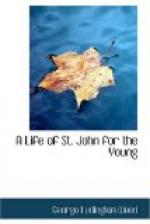Jesus was the flower of Mary’s family, the flower of Nazareth, of Galilee, of the whole land, and the whole world. Nazareth means flowery—a fitting name for the home of Jesus. It was rightly named. So must James and John have thought if their young cousin went with them to gather daisies, crocuses, poppies, tulips, marigolds, mignonette and lilies, which grow so profusely around the village. Did they ramble among the scarlet pomegranates, the green oaks, the dark green palms, the cypresses and olives that grew in the vale of Nazareth, and made beautiful the hills that encircled it? Did they climb one of them, and gain a view of the Mediterranean, and look toward the region where John would live when his boyhood was long past, in the service of his cousin at his side?
[Illustration: VIRGIN, INFANT JESUS, AND ST JOHN (Madonna della Sedia) Raphael Page 31]
A great artist, Millais, painted a picture of the boy Jesus, representing Him as cutting His finger with a carpenter’s tool, and running to His mother to have it bound up. Did John witness any such incident? How little did he think of a deeper wound he was yet to behold in that same hand.
We cannot answer such questions. These things were possible. They help us to think of Jesus as a boy, like other boys. James and John thought of Him as such only until long after the days of which we are speaking.
While thinking of John and Jesus as cousins, we may also think of a kinsman of theirs, a second cousin of whom we shall know more. John was to have a deep interest in both of the others, and they were to have more influence on him than all other men in the world.
There were some things common to them all. They were Jews. According to Jewish customs they were trained until six years of age in their own homes. Their library was the books of the Old Testament. They learned much of its teachings. They read the stories of Joseph, Samuel and David. At six they went to the village school, taught by a Rabbi. Some attention was paid to arithmetic, the history of their nation, and natural history. But, as at their homes, the chief study was the Scriptures. They were taught especially about One—“Of whom Moses in the law and the prophets did write.” Let us remember those words for we shall hear them again. That One was called the Messiah—He whom we call Jesus, the Christ, the Saviour of the world. He had not then come. We look back to the time when He did come: those boys looked forward to the time when He would come. The Messiah was the great subject in the homes of the pious Jews, and in the synagogues where old and young worshiped on the Sabbath.
[Illustration: CHRIST AND ST. JOHN Winterstein Page 34]
CHAPTER IV
The Great Expectation in John’s Day
Moses wrote of a promise, made centuries before the days of John, to Abraham—that in the Messiah all the nations of the earth,—not the Jews only—should be made happy with special blessings. Isaiah and other prophets wrote of the time and place and circumstances of His coming, and of the wonders He would perform.




